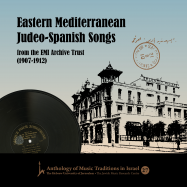(590 results found)
9. Ah niña sin piadad (CES)
… There is no other known version of this song. Salomon Algazi apparently recorded it too (Odeon … mos hablando que hacer. Ella de mucha pasión va echarte maldición. Aha, aha, va echarte maldición. … 10 … 7 … Eastern Mediterranean …
10. La seducida en la fuente (CES)
… This extremely widespread song of Hispanic origin is known among Sephardic Jews both … dijo la niña: Otro tres otro tres que son seš. Al despartirme de ella un abrazo me dió. De su devino rostro se las … n’el amor. … 10 … 7 … Eastern Mediterranean Judeo-Spanish Songs from the EMI Archive Trust (1907-1912) … Judeo-Spanish …
12. Las horas de la vida (CES)
… One of the most widespread and frequently recorded Sephardic songs throughout the twentieth century. The version by Haim … complete in existence. Originating in an Andalusian folk song, the CES version incorporates stanzas from other … modern Sephardic song that he may have heard from Spanish artists touring the Ottoman Empire. For a thorough study of …
13. Los árboles llorosos (CES)
… This song, derived in part from Greek traditional folk poetry … ajenas / yo me vo murir,” which forms an inseparable part of this song in the modern tradition (see Attias 1972 , …
14. El nacimiento y la vocación de Abraham (CES)
… patriarch Abraham, and is documented in written sources starting in the eighteenth century in manuscripts and in print … and in the oral tradition. This copla bifurcated into two songs with distinctive melodies. One, beginning “Cuando el Rey Nimrod,” is likely the most widespread Ladino song in the modern discography. It has a distinctive melody …
18. La hermosa durmiente (CES)
… This is one of the most popular Ladino songs both historically and up to the present, first … This recording, unlike most of the documented versions, starts with a rare stanza and not with the widespread one: … CES is unique in that in every second stanza the melody starts from the upper register. Pedrí tresoro, bienes y …
22. La galana (CES)
… A love song that apparently disappeared from oral tradition. … in Salonica at the beginning of the twentieth century. The article in the Ladino journal El Mesajero (Salonica, 1939, … to CES, cites a fragment from La galana: “Sin te olvidarte / de siempre amarte. / No esto por mi / no salgas loco. …
23. La palomba (CES)
… This is a parodic song based on the melody and the refrain of the famous … Iradier y Salaverri (1809-1865), entitled La paloma . This song, commercially recorded as early as 1899, had become … This version by CES is one of them, though it still partially preserves the original refrain of the Spanish song. …
24. El buceador (CES)
… that was well known in Salonica, but the rest of the song is totally different. Attias ( 1972 , no. 5) has documented this song with the opening “Se pasea Katina.” However, the … this song, all from Salonica, are Bunis ( 1999 , English part, p. 329, note 87, Se pasea Kadima , probably a …
27. El alma dolorida (CES)
… A song from the beginning of the twentieth century, it was … last stanza contrasts with the first five stanzas that start in flexible rhythm and ornamented style in each first … de mal sufrir. Pidrí oficio, bienes y vicios por alcanzarte, ah, mi querida. El rio pasa, l’arena queda El amor …



